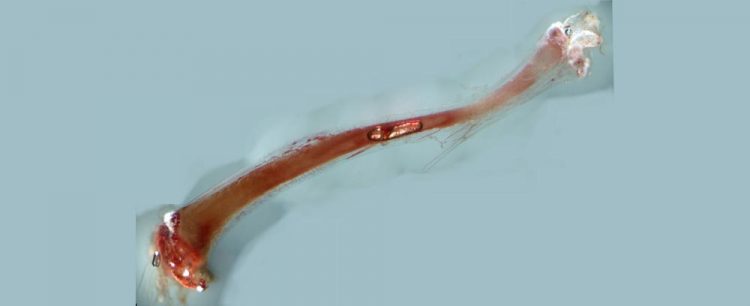New blood vessel system discovered in bones

Feinste Blutgefäße verbinden das Knochenmark direkt mit der Knochenhaut UDE/Matthias Gunzer, Annika Grüneboom
Bones are very hard organs. Still they do possess a tight meshwork of blood vessels in their inner cavity, where the bone marrow is located, as well as on the bone surface, that is covered by the highly vascularized periosteum.
This is why e.g. bone fractures can bleed extensively. The same blood vessel system is also essential to transport blood- and immune cells from their place of origin, the bone marrow, to the outside.
„Like any other organ also bones need a closed circulatory loop (CCL) to function properly. This delivers fresh blood via arteries into the bone and transports used blood out via veins. How exactly the CCL of long bones functions was not totally clear until now.” says Dr. Anika Grüneboom from the University Hospital in Erlangen, first author of the study.
She performed her PhD thesis in the group of Prof. Gunzer, where she completed most of the work, that has now been published.
Sometimes more than 1,000 capillaries per bone
In the long bones of mice, the team observed and characterized a new type of capillary that perpendicularly to the long axis crosses the entire hard bone, which is termed corticalis. Hence the new blood vessels were named “trans cortical vessels” (TCV) and the team found hundreds to more than 1,000 of those in e.g. a mouse tibia.
The vessels could either be of arterial or venous origin. Surprisingly, the scientists could demonstrate, that the overwhelming majority of arterial and venous blood in long bones flows through the TCV system.
Prof. Gunzer: „Previous concepts described just a handful of arterial inlets and two venous exits on long bones of mice. This is obviously too oversimplified and does not correctly reflect the true natural situation. It is really unexpected being able to find a new and central anatomical structure that has not been described in any textbook in the 21st century.”
This discovery was enabled by a unique combination of cutting edge imaging approaches that have been established and honed over many years. “Several of those methods have been used for the first time to study blood flow in bones.” says Prof. Gunzer. „This applies e.g. to the so-called Light sheet microscopy and 7 Tesla ultra high field magnetic resonance imaging.”
Research requiring full physical involvement
Using these techniques, it could be shown that TCVs also exist in human bones, at least in some parts of these much thicker structures. Thereby the study required full – also physical – involvement from all participants. Prof. Gunzer himself was lying in the 7 Tesla machine of the Erwin L. Hahn Institute at the UDE for ~6h until all necessary high-quality scans of his lower leg were in the box.
Future work shall now investigate which role is played by TCVs in normal bone physiology as well as under disease conditions such as osteoporosis, rheumatoid arthritis or tumors, that metastasize into bones.
Redaktion: Milena Hänisch, Medical Faculty, Tel. 0201/723- 6274, milena.haenisch@uk-essen.de
Prof. Matthias Gunzer, Institute for Experimental Immunology and Imaging, Tel. 0201/18 3-6640, matthias.gunzer@uni-due.de
Media Contact
More Information:
http://www.uni-duisburg-essen.de/All latest news from the category: Life Sciences and Chemistry
Articles and reports from the Life Sciences and chemistry area deal with applied and basic research into modern biology, chemistry and human medicine.
Valuable information can be found on a range of life sciences fields including bacteriology, biochemistry, bionics, bioinformatics, biophysics, biotechnology, genetics, geobotany, human biology, marine biology, microbiology, molecular biology, cellular biology, zoology, bioinorganic chemistry, microchemistry and environmental chemistry.
Newest articles

A ‘language’ for ML models to predict nanopore properties
A large number of 2D materials like graphene can have nanopores – small holes formed by missing atoms through which foreign substances can pass. The properties of these nanopores dictate many…

Clinically validated, wearable ultrasound patch
… for continuous blood pressure monitoring. A team of researchers at the University of California San Diego has developed a new and improved wearable ultrasound patch for continuous and noninvasive…

A new puzzle piece for string theory research
Dr. Ksenia Fedosova from the Cluster of Excellence Mathematics Münster, along with an international research team, has proven a conjecture in string theory that physicists had proposed regarding certain equations….



